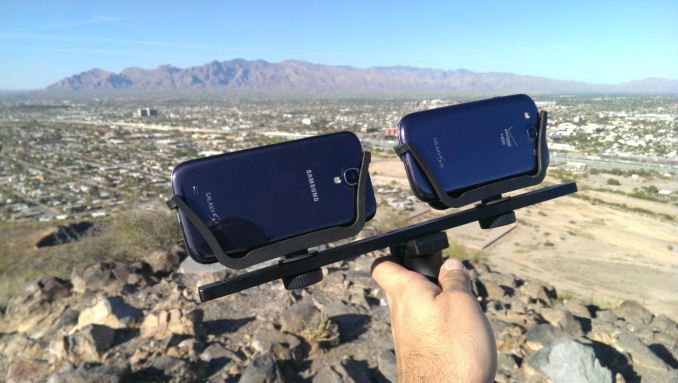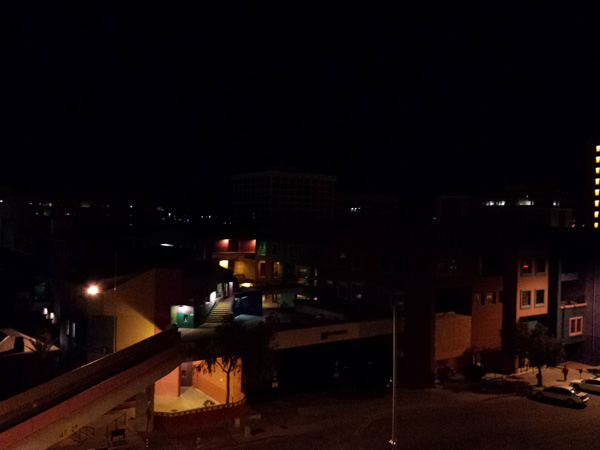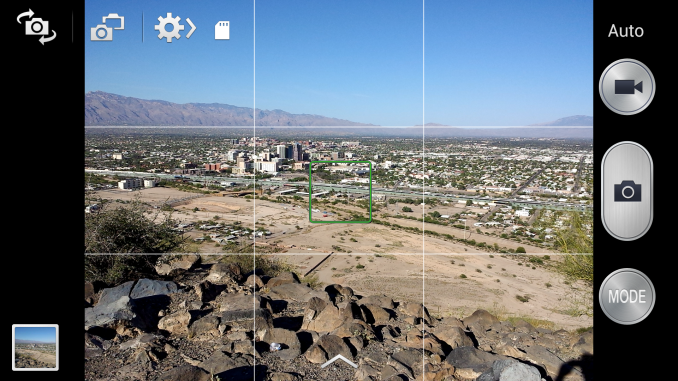Samsung Galaxy S 4 Review - Part 1
by Brian Klug on April 24, 2013 12:01 AM ESTCamera on SGS4
On the camera side Samsung is in an interesting position. The industry trend is overwhelmingly to go to more pixels and push the megapixel count up from 8 MP where most flagships sat last year to around 13 where they will sit this year. Samsung has to push that number to keep itself in a defensible and marketable position and at the same time deliver a camera experience that’s better than the previous year.
I published a table in the One review with the camera specifications from the previous generation. I’ve filled this in with confirmed information from the SGS4 review unit I have been taking samples with. With SGS4 Samsung does make some pretty considerable improvements, many of which undo some of the regressions that I described with SGS3. Focal length is now quite a bit longer, from the very wide SGS3 which was around 26mm in 35mm effective numbers, to 31 mm. This is a notable difference if you’re shooting with the two side by side, the SGS3 was always shockingly wide for a rear facing camera.
| Smartphone Camera Comparison - 2013 | |||||||
| HTC One | Samsung Galaxy S 2 | Samsung Galaxy S 3 | Samsung Galaxy S 4 | ||||
| Front Camera | 2.1MP | 2MP | 1.9MP | 2MP | |||
| Front Camera - CMOS |
OV2722 (1.4µm, 1/5.8") |
- |
S5K6A3 (1.75µm, 1/6") |
S5K6B2 (1.34µm, 1/6") |
|||
| Front Camera - Focal Length | ~1.59mm | 2.73mm | 2.7mm | 1.85mm | |||
| Front Camera - Max Aperture | F/2.0 | F/2.8 | F/2.8 | F/2.4 | |||
| Rear Camera | 4MP | 8MP | 8MP | 13MP | |||
| Rear Camera - CMOS |
ST VD6869 (2.0 µm, 1/3") |
S5K3H2YX (1.4µm 1/3.2") |
Sony/Samsung (1.4µm, ~1/3") |
IMX091PQ (1.12µm, 1/3.06") |
|||
| Rear Camera - Focal Length |
3.82mm (28mm eff) |
3.97mm (30mm eff) |
3.7mm (~26 mm eff) |
4.2mm (31 mm eff) |
|||
| Rear Camera - Max Aperture | F/2.0 | F/2.65 | F/2.6 | F/2.2 | |||
At the same time, F-number has improved dramatically, from the F/2.6 or 2.65 (I’ve seen both at times) aperture on the SGS3 to a much faster F/2.2. This dramatically improves the light collection abilities of the camera, by essentially a half stop. It’s difficult optical design to both keep the module thin enough to fit in the device without creating a huge bump (there’s a camera bump on SGS4, it’s there), increase focal length, improve F/#, and improve MTF for a better sensor all at the same time.
On the rear facing camera we see a Sony CMOS who continues to dominate the space, this time with an IMX091PQ sensor. On the front we Samsung’s own sensor, the S5K6B2 get used. Samsung also continues to go with a dedicated Fujitsu ISP inside the SGS4, this time it’s a new M10MO family which there isn’t a whole lot of information about. I suspect this continues to be done to mitigate the differences in SoC ISP between the APQ8064ab variant and Exynos 5 version and make tuning easier on Samsung’s camera team.
Imaging is increasingly a key differentiator for smartphones since it’s that device you always have on your person to take images with. For SGS4 camera is more of an emphasis this time around than it was with SGS3, which largely kept everything the same and just added software features. SGS4 brings better hardware and additional software features to do something with the hardware.
Outdoors in bright light the increased spatial resolution afforded from going from 8 MP to 13 MP helps. Samsung still does a lot of sharpening and there are halos around a ton of different features if you know where to look, but that’s the tuning they have opted for. I suspect we still are outresolving the sensor here, but I’m impressed with what I see with enough light. I took a lot of photos side by side with SGS3 and find SGS4 a notable improvement, but I’m not sure whether that’s just more damning commentary on SGS3 than anything else. I haven’t had time to put together many side by sides with buttons yet. I’ve been shooting with the HTC One on −2 sharpness since I prefer it that way, note that I accidentally left it this way with when making comparisons here since that’s still my daily driver until I can get an AT&T or T-Mobile SGS4 to use.
In lower light unsurprisingly we see the SGS4 offer better results than the SGS3 but still not quite as good as the HTC One. Samsung recently introduced low light shot on the SGS3 and Note 2, this feature carries over to the SGS4 but gets renamed back to Night Mode, even though behavior appears superficially to be the same. The SGS4 also introduces an auto night mode toggle, although this ships by default turned off. The mode automatically switches on night mode when it senses that you’re going to underexpose using the auto presets, I would advise basically leaving this on all the time. Unfortunately night mode introduces huge shot to shot latency that seems to be on the order of seconds — tap the button, capture runs, then there’s a progress bar that pops up while multiple exposures are ostensibly recombined into one image. You also have to be exceptionally steady to get an image without blur since it appears that this mode takes multiple images to get to the end goal — a better exposed image without tons of noise.
In the end there’s really no free lunch for anyone — you can temporally oversample (Samsung low light shot, or longer exposures with OIS like Nokia), or increase the size of your sampling area (larger pixels a-la HTC One), or do nothing and just give up unless you’re in a bright outdoor setting.
Samsung has introduced a bunch of new photo modes in the software on the SGS4, a number of which are actually pretty functional and awesome. There's the ability to create animated gifs from right in the camera, for example, where users paint a mask around the region they want animated from a short capture. This is essentially the same as Nokia's cinemagraph Lens from the Lumia 920, but it's still quite cool.
There's also dual camera, which lets you include a small overlay of the front facing camera atop the rear facing camera image. It initially struck me as a bit gimmicky but actually can be hilariously fun to share your face atop images to friends. It is also quite possibly the stuff of nightmares.
Panoramas on the SGS4 also are nicely put together and integrate continuously rather than get combined from a number of discrete images. The result is quite nice.
The user interface on SGS4 is a departure from the interface which has been present on previous Galaxy smartphones, and instead takes much UI/UX from the Galaxy Camera. Gone are the customizable toggles on the left side, instead options are in an expandable menu at the very top, and then another separate window. I got used to it pretty quickly but do miss the ability to customize the quick settings buttons on the left side and used to think that Samsung had the most powerful camera interface around. Things are moved around generally in a logical fashion however and I can understand how much this works to make transitioning between Galaxy Camera and SGS4 easy.
Video
When it comes to video, the SGS4 is records 1080p30 video at 17 Mbps H.264 High Profile.
I've done the usual thing and uploaded a sample to YouTube as well as our own servers for your inspection.
Video quality looks really nice and sharp on SGS4 from what I can tell by default. Anti shake (EIS in this case) is disabled out of the box, enabling it pops up a box warning you that stills captured during video record will be a different field of view.






























335 Comments
View All Comments
krumme - Wednesday, April 24, 2013 - link
Comparing at 200 nits, is fine, but at that brightness you actually get a more contrasty picture of Oled because of the darkness. For all practical usage - depending on your eyes - you can turn brightness relatively more down on the Oled.You might note that the color accuracy of the S4 is far better than the One. Thats not to mention the contrast. Ofcourse it lacks the brightness. But the presentation here is one sided.
If you find yourself at bars at night or shooting food at the restaurant go for the One camera. But before you do, you might want to compare the pictures plenty available on the net on fx. gsmarena or phonearena
UpSpin - Wednesday, April 24, 2013 - link
If the surrounding is bright, you need a bright display, which OLED struggles at, even with a better contrast, which gets more and more negligible the brighter your surrounding is. At night however you really see the difference between the true black OLED and greyish LCD.I don't know how to properly interpret the color charts, so I judge by the impression of the author which favors the HTC One display (see the HTC One review and this review 'Admittedly this mode does tighten things up a bit, but it still isn't perfect and I'd still like to see Samsung do something to reign this in at some point. ') and the numbers in the article:
HTC One vs. SGS4
Grayscale 200nits Avg dE2000: 5.391 vs. 7.511
CCT Avg (K): 8118 vs. 7020
Saturation Sweep Avg dE2000: 3.365 vs. 7.823
GMB ColorChecker Avg dE2000: 4.656 vs. 7.440
The color charts seem to look better for the SGS4, the 'Total gamma' and greyscale charts however disastrous.
krumme - Wednesday, April 24, 2013 - link
For practical usage i agree the brightness for most people can be an issue in sunlight. We just have to remember there is much more at play here than just brightness.But at the same way using a phone in bright surroundings favor the saturation of Oled.
I never understand the standard setting on the S2 or S3. It gave stupid colors imho (and the sharpness wasnt there either imho compared to LCD competition). But if you chose fx. natural on the S3 i think you are pretty much where the colors is okey for everything personal. Its the grey scale that suffers - the shaddow details is very bad imho. Apparently thats still an issue on the S4.
But the basic problem about reviewing the display this way, is that we get zero numbers for the all important dynamics of the picture. And its just so obvious for the eye that oled got something here.
nerd1 - Wednesday, April 24, 2013 - link
What matters is the perceived CONTRAST, not the brightness itself.Practically AMOLED has better contrast overall, which helps sunlight reading a bit although bit dimmer.
sigmatau - Thursday, April 25, 2013 - link
I feel you are just guessing based on what you see on paper. My Samsung AMOLED plus screen is useless in the sun with full brightness. Most reviewers said that the HTC's screen kills the S4's screen. I am thinking of buying an HTC One and trying it out for a day or two before deciding. I really do like the blacks on OLED screens.krumme - Thursday, April 25, 2013 - link
Nonsense. Plenty sites gives the edge to Samsung. But i guess most just turn the autopilot on. Something happened since your amoled screen. Sunlight legibility is a personal matter, because reflection also plays a big role.sigmatau - Thursday, April 25, 2013 - link
Bull shit. My OLED screen is the best with Nokia's superior filter and still is terrible in the sunlight. I have to find shade just to use the phone. And remember, mine is a plus OLED screen, these on the S3 and S4 are not, which makes them worse.UpSpin - Thursday, April 25, 2013 - link
The glass reflects a lot of the sunlight.The display must be brighter than the reflections to remain readable. That's independent of contrast in the first place. So either reduce the reflections (AR coating, Nokia polarisation) or increase the brightness. The contrast isn't important in the first place here. OLEDs have a lower brightness than LCD, thus, and just as every review talking about outdoor use agrees with, LCD is much better readable outdoors.If you have a very dark display with an impressive contrast you won't see anything in sunlight, because the reflections are much brighter than the content on your display.
Special outdoor display also don't just have RGB, but RGBW, just to make it even brighter for outdoor use.
krumme - Thursday, April 25, 2013 - link
Go here to see an measurement of sunlight contrast ratio:http://www.gsmarena.com/samsung_galaxy_s4-review-9...
S4 is quite good, and if i recall about the same order as One.
ssj3gohan - Wednesday, April 24, 2013 - link
Wait a sec... you have an LTE/HSPA synthesizer, right? Why don't you try out battery life with that, so you're guaranteed to have equal signal strength, bandwidth and latency throughout the tests instead of having to rely on different vendors, signal quality and concurrency.